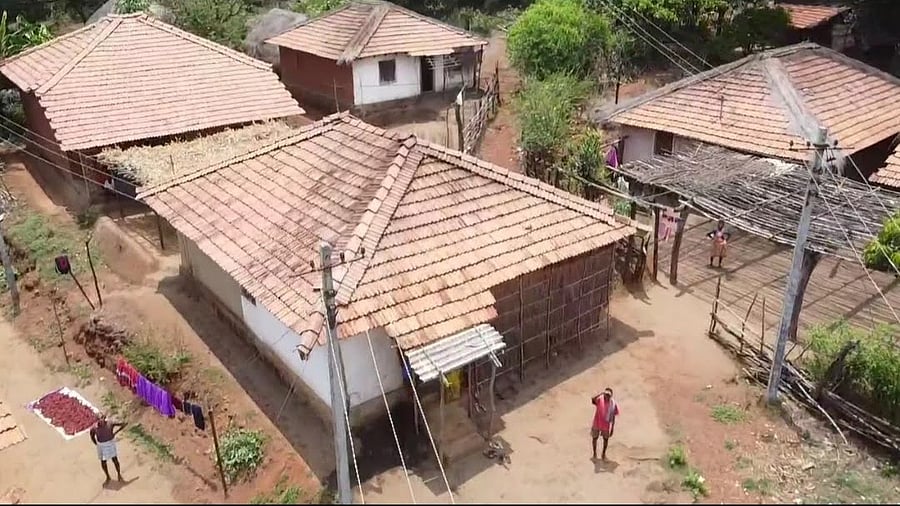
Three of the five tiger reserves in the state have 90 villages within the core area, with 5,442 families living there.
Credit: DH FILE PHOTO
Hubballi: The forest department has, over the last five years, received 1,076 applications from forest dwellers for voluntary relocation. However, only 498 have been processed.
According to a statement by Forest Minister Eshwar Khandre in the Legislative Council recently, all 498 relocations were done in Kali tiger reserve - KTR (out of 818 applications from there). The applications received are 230 and 28, respectively, for Male Mahadeshwara wildlife sanctuary and Sharavathi valley lion-tailed macaque sanctuary.
Department sources told DH that due to lack of funds, they were unable to take up relocation in other protected areas.
Three of the five tiger reserves in state have 90 villages within core area, with 5,442 families living there. KTR has the highest number of 4,104 families in core area, followed by Nagarahole (1,280) and Bhadra 58.
Since the commencement of relocation in 2009, KTR has received 1,592 applications for voluntary relocation, out of which it has relocated 607 beneficiaries, including 338 from core areas. Currently, KTR has 985 pending applications, out of which 759 are from core area.
The highest number of relocations was taken up in the last five years as KTR, the only tiger reserve in North Karnataka, received over Rs 80 crore from Compensatory Afforestation Fund Management and Planning Authority (CAMPA).
Activists say officials at KTR did not follow guidelines of National Tiger Conservation Authority (NTCA), which favours relocation from only core and critical areas of tiger reserves. But forest officials refute the charges.
So far, the department has implemented relocation of forest dwellers in 50 hamlets in KTR, of which 36 are in core areas and 14 in buffer areas.
Rules violated: Activist
Reshma B, Mangaluru-based activist, in a letter to central and state governments, has alleged that relocation was done in blatant violation of Wildlife Protection Act (WLPA), 1972.
Her letter highlights that section 1.4 of NTCA guidelines states voluntary relocation of people needs to be done only in identified core/critical tiger habitats of tiger reserves.
“Officials in KTR have rehabilitated 248 families from buffer areas, a clear violation of WLPA and Forest Rights Act (FRA), 2006,” says her letter.
She says many families from villages (Sulavali, Amagaon, Kalabhavi, Audit No 2, etc), who had encroached forest land, had been compensated and rehabilitated, a clear abatement of WLPA, Forest Conservation Act and FRA.
Maria Christu Raja, former field director of KTR under whose tenure a majority of the villages were rehabilitated, says there is no violation of rules and all voluntary relocation was implemented as per proposals submitted to NTCA and CAMPA. “Guidelines do not prohibit voluntary relocation from buffer areas. Several tiger reserves across India have done that and continue to do so. NTCA approves such proposals on merit,” he says.
NTCA guidelines clearly state that they had necessarily been kept broad and generic, for states to refine procedures as per their requirements.
Nilesh Shinde, KTR field director, says: “We are undertaking voluntary relocation as per NTCA and CAMPA guidelines. The relocation is proving to be a meaningful step for both wildlife conservation and community upliftment.”
This DH reporter, who visited Sulavali, Amagaon and Diggi villages multiple times, has witnessed wildlife taking over vacated lands and socio-economic conditions of displaced persons improving, with better health and other facilities.
Win-win solution
Wildlife conservationist Praveen Bhargav says it is the constitutional right of a forest dweller to voluntarily relocate. “Any law or guideline that curbs the fundamental right to move and resettle will be void. Nothing can stop a dweller from accepting compensation and resettling to a better location.”
He says projecting voluntary resettlement as ‘eviction’ not only demoralizes good officers, but is also a sinister attempt to prevent win-win solutions for humans and wildlife.